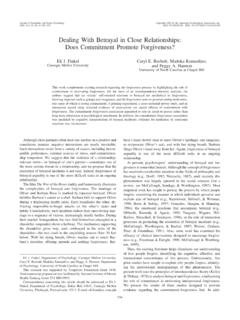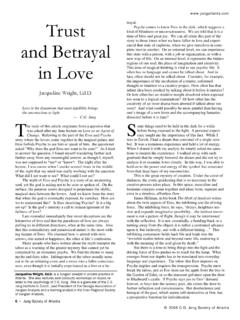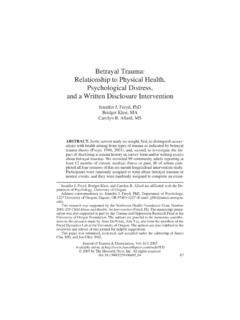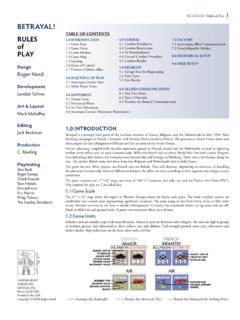Transcription of CSAT Trauma Bonds Course - Healing TREE
1 Trauma Bonds by Patrick J. Carnes, , CAS Abandonment and Trauma are at the core of addictions. Abandonment causes deep shame. Abandonment by betrayal is worse than mindless neglect. betrayal is purposeful and self-serving. If severe enough, it is traumatic. What moves betrayal into the realm of Trauma is fear and terror. If the wound is deep enough and the terror big enough, the body alters. The system elevates into an alarm state, never safe. Waiting for the hurt again. In that state of readiness the client doesn t notice that part of them has died. The client is grieving. Like everyone who has loss, the clients have shock and disbelief, fear, loneliness, and sadness. Yet the clients don t notice because their guard is up. In their readiness, the clients abandon themselves. Yes, another abandonment. What we see is highly addictive attachment to the persons who have hurt the clients. The clients may even blame themselves, their defects, their failed efforts.
2 The clients strive to do better as their lives slip away amongst all the intensity. These attachments cause the clients to distrust their own judgment, to distort their own realities so much, the clients can place themselves at more risk. The clients are bracing themselves against further hurt. Taking precautions which almost guarantee more pain. These attachments have a name. They are called Trauma Bonds . Exploitive relationships create Trauma Bonds . These occur when a victim Bonds with someone who is destructive to them. Similarly, adult survivors of abusive and dysfunctional families struggle with Bonds that are rooted in their own Trauma experiences. To be loyal to that which does not work - or worse, to a person who is toxic, exploitive, or destructive to the client, is a form of insanity. A number of signs exist for the presence of a betrayal bond : 1. When everyone around the client is having negative reactions so strong the client is covering up, defending, or explaining a relationship.
3 2. When there is a constant pattern of non-performance and the client continues to expect them to follow through anyway. 3. When there are repetitive, destructive fights that are no win for anybody. 4. When others are horrified by something that has happened to the client and the client isn t. Trauma Bonds Page 2 of 21 5. When the client obsesses about showing someone that they are wrong about the abuse, their relationship, or their treatment of the client. 6. When the client feels loyal to someone even though the client harbors secrets that are damaging to others. 7. When the client moves closer to someone who is destructive with the desire of converting them to a non-abuser. 8. When someone s talents, charisma, or contributions causes the client to overlook destructive, exploitive, or degrading acts. 9. When the client cannot detach from someone even though the client does not trust, like or care for the person. 10. When the client misses a relationship even to the point of nostalgia and longing that was so awful it almost destroyed the client.
4 11. When extraordinary demands are placed on the client to measure up as a way to cover up exploitation of the client. 12. When the client keeps secret someone s destructive behavior because of all of the good they have done or the importance of their position or career. 13. When the history of their relationship is about contracts or promises that have been broken, which the client are asked to overlook. They all involve exploitation of trust or power or both. They all can result in a bond with a person who is dangerous and exploitive. Signs of betrayal bonding include misplaced loyalty, inability to detach, and self-destructive denial. Professional therapists can be so focused on their client s woundedness; they will overlook the Trauma Bonds that may remain. Finally, consider the context in which Trauma Bonds are most likely to occur: Domestic violence Dysfunctional marriages Exploitation in the workplace Religious abuse Litigation Kidnapping Hostage situations Trauma Bonds Page 3 of 21 Cults Addictions (alcohol, drugs, gambling, eating, sex, and high risk) Incest and child abuse Violence in other lands is closer than before.
5 Terrorism and hatred leak across our borders. No longer can we say that is not our problem. The experience of 9/11 underscores the need for awareness about Trauma . Between 1985 and 1993 exposure to violence increased 176% for the average junior high school student. Fifty per cent of women in our culture will experience some form of sexual assault during their lifetimes Effects of Trauma on the Brain When people are profoundly frightened, Trauma creates a biological alteration of the brain. At birth, only primitive structures like the brain stem (which regulates fight/flight) are fully functional. In regions like the temporal lobes (which regulate emotions and receive input from the senses), early experiences wire the brain circuitry. When early Trauma /deprivation are present, the circuitry to and within the temporal lobes are profoundly affected, resulting in emotional and cognitive problems. Our primary brain goes into stimulation and is flooded with neurochemicals.
6 When the source of the fear goes away, the chemicals go away. The person experiences cravings. They can become attached to Trauma . People become reactive human beings-going from stimulation to action without thinking. PTSD is reacting years later to early Trauma events Two factors are essential in understanding traumatic experiences. How far our systems are stretched and for how long. Some events happen only once or just a few times, but the impact is so great that Trauma occurs. Trauma by accumulation sneaks up on its victims. They become acclimatized. Traumas that are horrendous and long lasting are the worst. Such was the holocaust. Or Vietnam or 9/11. Emotional scars can be so severe that generations descended from those surviving will react in ways that still reflect the original Trauma . No amount of normalcy makes it safe. Patterns and attitudes evolve far beyond the individual and are incorporated into family and society. Trauma Bonds Page 4 of 21 Here are nine predominant ways that Trauma continues to affect people over time.
7 They are: 1. Trauma reaction 2. Trauma arousal 3. Trauma pleasure 4. Trauma blocking 5. Trauma splitting 6. Trauma abstinence 7. Trauma shame 8. Trauma repetition 9. Trauma Bonds 1. Trauma Reaction Definition: Physiological and/or psychological alarm reactions from unresolved Trauma experience. Clinical Patterns: Flashbacks; intrusive thoughts; insomnia; triggered associations; troubling dreams; physical symptoms; hyper vigilance; living in extremes; bipolar cycles; Borderline Personality Disorder; victims of violent crimes, soldiers, sexual abuse survivors Coping mechanisms would become overwhelmed to the extent that they could not function. Now remember that the brain, body, and nervous system will adjust. They will acclimatize. So for survival they continue by burying the horrifying experiences into compartments in the brain. Later, sometimes many years later, the compartments start to leak. The veteran re-experiences the terror and at times with the same realism of the original experience.
8 Therapists call this Post Traumatic Stress Disorder or PTSD. The stress of the Trauma continues long after the actual traumatic event. Living in such reactivity takes a toll on the body. For example, women who were sexually abused as children are eight times more likely to have cancer than women who were not abused. Some researchers make a strong case that the impact of Trauma is encoded right down to a cellular level. Trauma Bonds Page 5 of 21 Clinical Strategies for Trauma Reactions: Cognitive reframing of Trauma experiences Hypnotic desensitization Teach PTSD concepts Implement relapse prevention and other skills Controlled breathing Stress management techniques Developing meaning from victimization Therapeutic storytelling Systematic desensitization Re-experiencing the Trauma in a safe environment Deep muscle relaxation Thought stopping strategies Guided self-dialog Role playing Covert modeling Diaries and self-monitoring EMDR 2.
9 Trauma Arousal Definition: Seeking/finding pleasure in the presence of extreme danger, violence, risk or shame. Clinical Patterns: Sado-masochism; sex offending; prostitution; high risk experiences; arousal addiction. Some soldiers in Viet Nam used sex as a way to escape the horror of war. They experienced sex in ways that are irreproducible in a peace time country. High risk sex had become like a drug which stimulated the system (like amphetamines), as an antidote to the pain. Coming home meant they could Trauma Bonds Page 6 of 21 find no parallel experience, so they simply became violent. It was the closest way they could experience that rush. Some girls had their first sexual experiences under scary or even violent conditions. They found it pleasurable and felt responsible. As adults the only way they can be orgasmic is if a man is hurting them. Their behavior becomes supercharged and highly addictive. They may work as prostitutes or hit the S and M clubs.
10 Either way they find willing partners who will re-victimize them. Some executives, in an effort to compensate for horrible experiences as children, find an exhilaration in the climb to power. As CEO s of billion dollar corporations they only feel alive when dealing with crisis or huge risk. Leveraged buyouts, takeovers, and acquisitions become the bets of just another form of compulsive gambling. Hooked on the stress of extraordinary power and the risk of losing everything, they cannot leave their job. Deal making twenty hours a day, they can hardly sleep or be with their families. They play with traumatic possibility and cannot leave it alone. For recreation they love high speed motorcycles, sky-diving, and other high risk diversions. Some professionals (clergy, physicians, attorneys) will have sex with those entrusted in their care (parishioners, patients, clients). Some of these develop a pattern of high risk sex that is clearly addictive.









